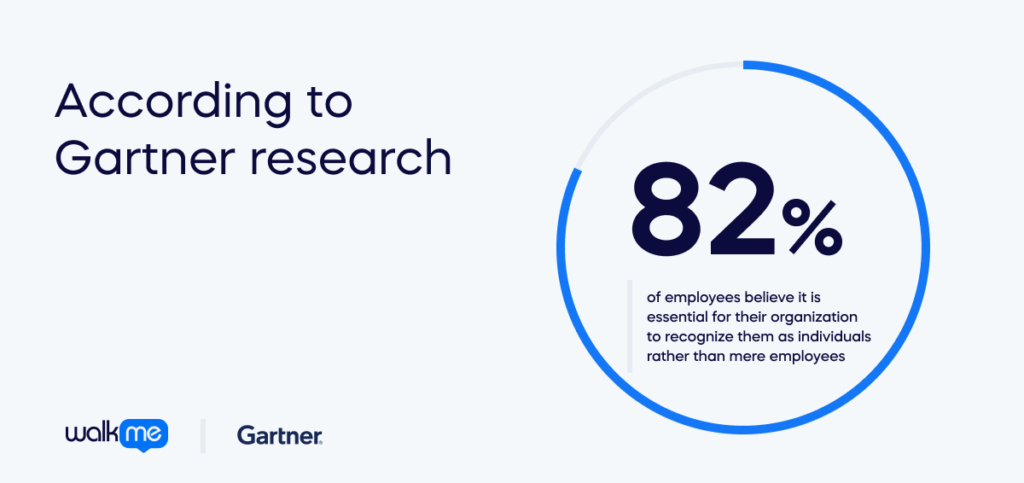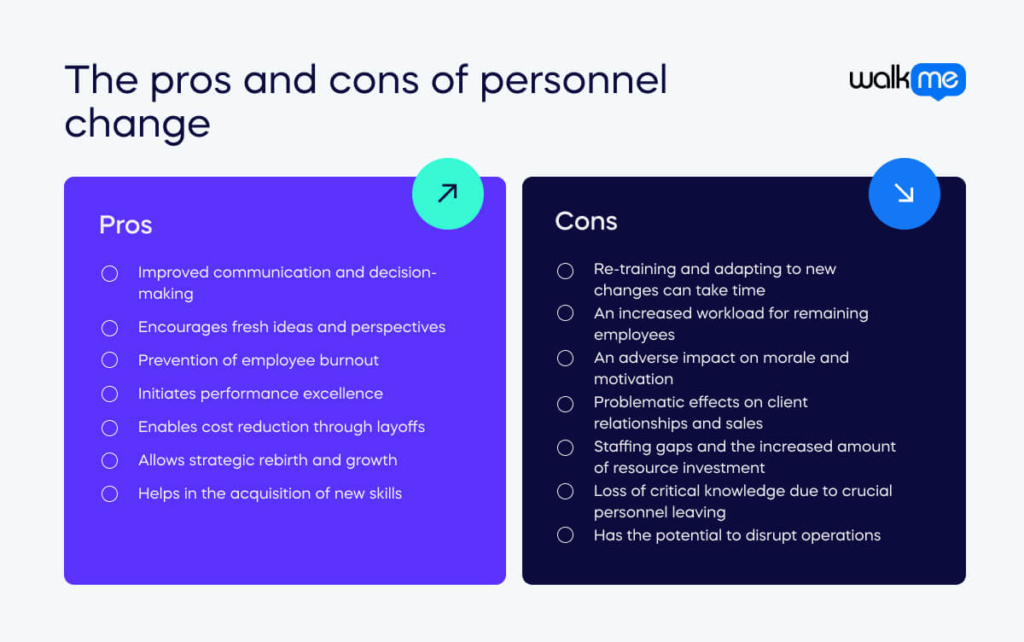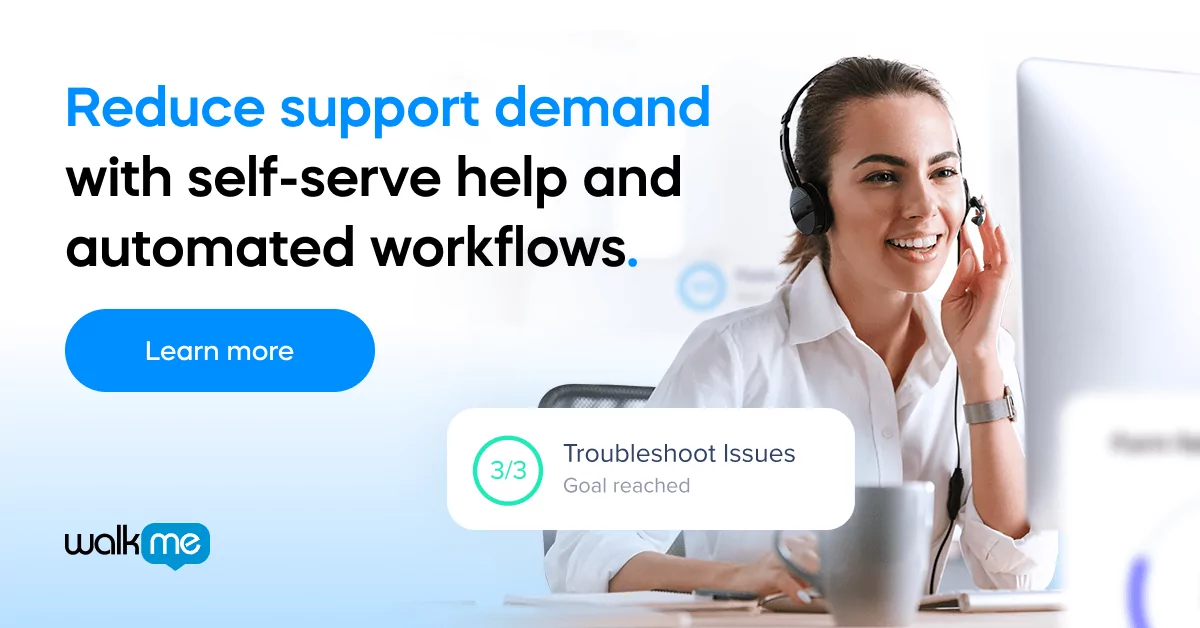Change can be unsettling, mainly when variables are beyond our control. In reality, change management seldom unfolds in ideal conditions, often impacting employees who must navigate, embrace, and adjust to new work methodologies.
The challenge becomes even more significant when personnel changes are intertwined with broader situations like mergers, acquisitions, divestitures, layoffs, and restructuring.
In such scenarios, leaders may be uncertain about what information they can share, sometimes opting for silence, leaving remaining employees feeling frustrated and resentful toward the changes.
However, this is a significant misstep in personnel change, as delaying leadership involvement allows the change to take on a life of its own.
Instead, during these challenging periods, change leadership should concentrate on expanding awareness, increasing visibility, fostering trust, and, at the very least, managing expectations to ensure the ongoing success of their organization in the face of personnel changes.
This article will explore various aspects of personnel change. You will understand what personnel change is and its purpose, whether it requires a human-centric approach, how to implement it effectively, some practical examples of its application, and the pros and cons associated with personnel change.
What is personnel change?
Personnel changes encompass various alterations in an organization’s workforce, including the addition and departure of employees.
On the one hand, personnel changes may involve recruiting new staff or advancing current employees. Conversely, they can also pertain to the termination of existing employees, voluntary resignations, or large-scale workforce layoffs.
What is the purpose of personnel change?
Personnel changes are often instigated as a response to financial challenges or pressures a company faces.
Through these human-centric organizational adjustments, companies aim to mitigate costly inefficiencies, adapt to evolving competitive markets, and formulate effective strategies to navigate and thrive in the future.
Does personnel change require a human-centric approach?
The reasons behind organizational personnel changes are diverse, ranging from increased external competition and internal departmental rivalries to stagnation, the drive for innovation, revenue setbacks, resource reallocation, process overhauls, and the imperative to enhance employee productivity processes.
However, despite the apparent simplicity of these changes from an organizational perspective, their successful execution is profoundly influenced by the human factor within the company. While organizations can introduce new structures, processes, and ideas, motivating employees to accept and advocate for these changes is the real challenge.
This necessitates comprehensive employee training initiatives to ensure employees understand the organization’s mission and adapt effectively to new structures and tools.
Regardless of the driving force behind the change or the organization’s approach, a well-thought-out change management process is crucial. Such a strategy should include a comprehensive training plan aligned with the company’s strategic vision, leadership objectives, organizational culture, and desired changes in employee behavior.
After a poorly managed personnel change, remaining employees may no longer feel valued or perceive that they contribute meaningfully to the organization. This can lead to further attrition as employees choose to leave.
According to Gartner research, 82% of employees believe it is essential for their organization to recognize them as individuals rather than mere employees, yet only 45% believe their organizations do so. As a result, a human-centric approach becomes increasingly critical.

Organizations can enhance their productivity by giving employees more control over their work and environment, particularly following transformative personnel changes. This approach focuses on the employee experience and promoting their well-being, ultimately contributing to a thriving and adaptable organizational culture.
How to implement personnel change

Navigating personnel changes within an organization can be a complex and delicate process. It involves much more than just rearranging roles and responsibilities; it requires a thoughtful and strategic approach to ensure that employees and the organization benefit from the enterprise transformation.
Effective personnel change management is essential in today’s dynamic business landscape, where adaptability and agility are crucial for success.
Here are some important points to consider when implementing personnel changes:
Clear communication from the start
Individuals want purpose and meaning in their work. They want to understand the ‘why’ behind changes in the organization. Therefore, it is vital to communicate openly and honestly with employees about the reasons for personnel changes.
Clearly articulate the company’s mission, vision, and values to provide a sense of purpose. Regular training sessions help reinforce these principles, ensuring they are embedded in daily operations.
Organise training following the change
People are generally more willing to embrace change when they understand its necessity and how it will benefit them and the company. Training plays a pivotal role in facilitating co-creation and proactive change management.
By allowing employees to enhance their skills, they become better equipped to adapt and contribute positively to change. Training should also include adapting to new tools and methods introduced across the organization.
Consider unintended consequences of personnel change on the remaining employees
Layoffs, a common aspect of personnel changes, can have unintended consequences. These may include the loss of valuable knowledge and skills, a higher risk of employee burnout, supply chain disruptions, unintentional biases, and potential legal issues.
It’s crucial to identify the most likely risks for your business and proactively develop strategies to mitigate them before taking action or sharing internal communications.
Maintain transparency with changes
Transparency is a cornerstone of successful personnel changes. Open and honest communication through various channels, such as company emails, intranet articles, meetings, and corporate events, is crucial.
Employees should be informed about the organization’s health, progress, and the rationale behind the changes. Transparency fosters trust and shared responsibility for the company’s success.
Empower employees with choice
Providing employees with choices during personnel changes can empower them and increase their engagement.
Whether involving them in decision-making about new teams or seeking their preferences about the training they receive, genuine consideration of their input is essential. Avoid situations where choices are merely symbolic, often increasing frustration and lowering morale.
Ensure regular and effective communication at all times
Every employee may have unique concerns and questions during personnel changes. While team meetings are an excellent way to communicate broadly, one-on-one meetings with direct managers can address individual issues, such as changes to job requirements, salary, job title, reporting structure, office location, and travel expectations.
Additionally, job security is a significant concern for employees during change, particularly after personnel changes.
Effective communication is vital to reassure employees about the purpose of layoffs and how they will position the company in the future. Employees need to understand that the changes are part of a strategic plan for long-term success.
Maintain your reputation
As a result of social media, disgruntled employees can quickly amplify their grievances, potentially damaging a company’s reputation. A well-defined strategy to mitigate risks and respond promptly to negative publicity is essential for protecting the organization’s brand.
Plan for your future workforce to prevent too many personnel changes
Strategic workforce planning is essential to align future workforce needs with the current skill set within the organization. Conducting a skills gap analysis and providing opportunities for upskilling can help employees adapt to changing roles, work structures, and agile teams.
Monitor and sustain the results of the change over time
Personnel changes are not a one-time event but an ongoing process. Employees need time to adapt and see the results of the changes. Regular updates on progress and celebrations of even small victories can motivate and engage employees.
It is crucial to recognize employees’ dedication and perseverance throughout the personnel change process. Offering bonuses, perks, or special treats as a token of appreciation can boost morale and create a positive work environment.
Practical examples of personnel change
Numerous companies have effectively implemented change management processes to transform their organizations completely.
Let’s briefly examine the experiences of two companies:
Microsoft
Satya Nadella is widely recognized for his remarkable leadership in revitalizing Microsoft’s fortunes. Over the past decade, he has guided the company’s market capitalization from $381 billion to an astonishing $3 trillion.
When Nadella assumed the CEO role at Microsoft in 2014, the company faced stagnation and needed help to keep pace with technological innovation. Today, it stands at the forefront of the AI era, widely regarded as the next technological frontier.
Upon taking the helm in February 2014, Nadella embarked on a formidable mission to restructure Microsoft. He set out to streamline the company’s vision by uniting employees behind common objectives. These objectives encompassed reinventing productivity and business processes, forging an intelligent cloud platform, and advancing personal computing.
One of Nadella’s early actions in 2014 was implementing significant personnel changes. His vision was to create a leaner and more agile Microsoft, capable of anticipating and innovating with greater speed. As part of this transformation, he aimed to flatten the organizational hierarchy.
He urged the Microsoft leadership team to propose ideas for simplifying operations and work processes. The overarching goal was to refocus Microsoft on its core mission, as defined by Nadella, and ensure the company delivered value to its users and customers.
Before this reorganization, Microsoft needed a clear sense of purpose among its employees. This absence of direction naturally resulted in decreased employee engagement.
Nadella’s strategic approach can be divided into two distinct phases. In the initial phase, he initiated a transformational shift within Microsoft, focusing on agile development and cloud delivery.
A cultural shift within the organization complemented this transformation. In the second phase, the emphasis shifted towards investments in AI-driven consumer software, exemplified by innovations like ChatGPT.
Under Satya Nadella’s visionary leadership, Microsoft has grown remarkably and positioned itself as a pioneering force in technology and artificial intelligence.
Sonae
Sonae, a multinational corporation, serves as a compelling exemplar of how a human-centric approach to change can minimize personnel turnover. CEO Cláudia Azevedo underscores the significance of having the right individuals with the appropriate mindset in leadership roles and on the board, extending this principle across the entire organization, from the front lines to the C-suite.
Recognizing the imperative of retaining top talent, Sonae is actively reevaluating its remuneration strategy and career progression frameworks, adapting them to align with the evolving priorities of today’s workforce.
Through strategic workforce planning, Sonae has gained insights into the implications of reskilling and upskilling for the organization.
They have meticulously identified the roles susceptible to automation while emphasizing that digital process automation can enhance the human aspect of jobs. Routine tasks can be automated, but those requiring creativity and genuine human interaction remain indispensable.
Furthermore, the pursuit of purpose resonates with individuals from diverse professional backgrounds. Sonae has made purpose a focal point of its organizational ethos, establishing a clear employee identity and expectations.
This shared purpose transcends business segments, be it food or electronic retail. Sustainability, deeply ingrained in Sonae’s purpose, offers employees opportunities to engage actively in initiatives through a sustainability forum. This team-focused approach fosters a sense of pride among employees, connecting them to the company and its customers.
In the day-to-day work environment, employees seek good leadership, a conducive workplace, competitive compensation, and a merit-based rewards system as the foundational elements, all of which Sonae diligently provides.
Beyond these basics, Sonae emphasizes creating avenues for career development in diverse directions. A ‘zigzag’ approach is employed to curtail personnel changes, allowing employees to gain exposure to various business facets and professional experiences within the company.
This strategic approach enables Sonae to offer immensely gratifying career trajectories, attracting and retaining the finest talent while affording employees opportunities for continuous training within the organization, reducing the urge to explore other employment options.
The pros and cons of personnel change

People tend to find comfort in established routines, and when employee-related changes disrupt these patterns, it can create a sense of unease.
However, it’s important to note that personnel changes also come with several advantages, including:
Improved communication and decision-making
Eliminating unnecessary bureaucracy due to personnel change can streamline communication and decision-making processes. Simplifying management reorders the organizational hierarchy, fostering open communication, and removing obstacles to productivity.
Encourages fresh ideas and perspectives
New employees introduced through personnel changes can bring innovative ideas and fresh perspectives to the organization. Embracing these ideas encourages innovation, helping the business stay competitive and enter new markets.
Prevention of employee burnout
Overworked existing staff can experience a decline in the quality of their work due to burnout. Hiring new talent as part of personnel changes to share the workload can prevent burnout, ensuring sustained productivity.
Initiates performance excellence
Changes in management or personnel often motivate everyone in the company to elevate their performance, remain competitive, and embrace a learning culture.
Even more, friendly competition and an internal drive to excel can lead to career growth opportunities when challenges are embraced rather than resisted.
Enables cost reduction through layoffs
Mass layoffs can significantly reduce employee-related costs, such as compensation and benefits packages. This cost-cutting measure helps companies regain financial stability and exercise better control over their finances.
Allows strategic rebirth and growth
A well-executed personnel change can reinvent the organization and position it advantageously relative to competitors. Such strategic change initiatives can pave the way for growth, acquiring new accounts, or expanding into new locations.
Helps in the acquisition of new skills
New employees bring different perspectives and introduce a wide range of skills. Whether soft skills or technical expertise are required, hiring new talent can sometimes be more efficient than training existing employees in new roles.
Conversely, personnel change also comes with its disadvantages, mainly if not managed well:
Re-training and adapting to new changes can take time
Personnel change often necessitates retraining employees on evolving or entirely new processes and methods. During this transition, productivity may temporarily dip as employees navigate the change curve.
Additionally, employees must learn to use and acclimate to any new technologies introduced as part of the change.
An increased workload for remaining employees
When layoffs occur due to personnel change, the remaining employees must often take on additional responsibilities to fill the gaps left by terminated coworkers.
This can lead to increased workloads and challenges in managing the added tasks effectively.
An adverse impact on morale and motivation
Layoffs due to personnel change can harm company morale and motivation among remaining employees. The fear of job insecurity and increased workloads can cause uncertainty and stress within the organization.
Problematic effects on client relationships and sales
Changes in job assignments due to personnel changes can disrupt customer experience relationships and potentially lead to reduced sales. The fewer employees available to handle the workload may affect service quality and responsiveness.
Staffing gaps and the increased amount of resource investment
Personnel changes, such as terminations or turnover, create staffing gaps that require significant time and resources. Recruiting, hiring, employee onboarding, and training new employees require substantial effort.
It takes time for new hires to reach the required performance levels.
Loss of critical knowledge due to crucial personnel leaving
In cases where employees leave or are laid off following personnel changes, the company may lose valuable customer and business information and knowledge.
Critical insights into problem-solving methods, customer preferences, operational approaches, and company history may be lost during these transitions.
Has the potential to disrupt operations
The adjustment period during personnel changes can disrupt day-to-day operations, potentially affecting service delivery, project timelines, and overall business performance.
It may take time for the organization to stabilize and regain its operational rhythm.
Final steps on personnel change
In today’s landscape, employees anticipate more profound connections, a robust sense of community, and work driven by purpose.
When employers restrict the elements contributing to this sense of purpose, employees are less likely to remain committed to their roles.
Hence, adopting a human-centric approach to change has become imperative for every organization.
Such an approach acknowledges the evolving expectations of the modern workforce and contributes to the organization’s ability to thrive in an ever-changing landscape.
It is essential to involve and inform employees about personnel changes so that they can take ownership of their capacity to adapt effectively.
This endeavor calls for strategic commitment from transformational leadership to guide employees through change by fostering a purpose-driven culture, leveraging technology, and providing the necessary training and support.


